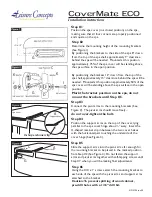
6.DISCHARGING CONTROL MODE
77
●
The Over/Under comparison timing depends on the Over/Under comparison mode setting
(Weighing Function 2 in setting mode 2).
(It is set at “Regularly” in the illustration.)
●
The completion signal output timing depends on the complete signal output mode setting
(Weighing Function 2 in setting mode 2).
●
t1 : Comparison Inhibit Time
Comparison Inhibit Time in setting mode 1
t2 : Judging Time
Judging Time in setting mode 1
t3 : Complete Output Time
Complete Output Time in setting mode 1
●
Conditional expression
- Near Zero turns ON when Weight value
≦
Set value of Near Zero
- SP1 output turns ON when Weight value
≧
Final - SP1
- SP2 output turns ON when Weight value
≧
Final - SP2
- SP3 output turns ON when Weight value
≧
Final - CPS
- Under turns ON when Weight value
<
Final - Under
- Over turns ON when Weight value
>
Final + Over
- Go turns ON when Final + Over
≧
Weight value
≧
Final - Under
●
Select the weight value for Near Zero comparison from Gross weight/Net weight (Weighing
Function 1 in setting mode 2).
●
Select the comparison weight value for Set Point 1, Set Point 2 and Set Point 3 output signals,
and Over, Go and Under judgment signals from Gross weight/Net weight (Weighing Function 1
in setting mode 2).
6-2-2. Sequential Control
This is a control method which compares the weight value with discharging value after starting
signal of weighing ON.
When the starting signal ON, output of each signal of Set Point 1, Set Point 2, and Final turns ON
then the signal turns OFF after weight value satisfied the each condition.
Sequential control can be conducted without connecting external sequencer in sequence control.
Sequence controls are classified into following categories.
1) Normal sequence control
Start weighing with start signal and finish the weighing by the output of complete signal.
2) Sequence control with adjust feeding
Adjust feeding is executed for the set period in adjusting time after completing the weighing.
















































